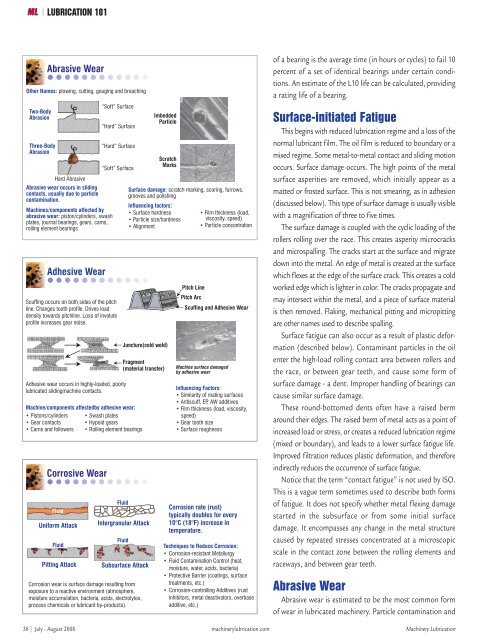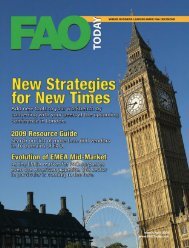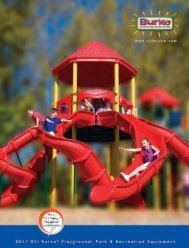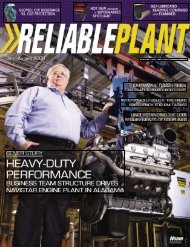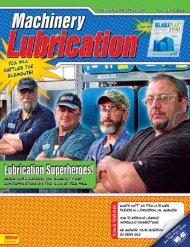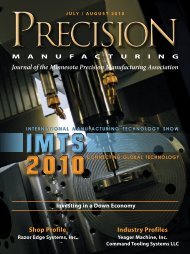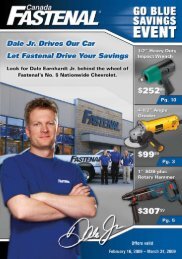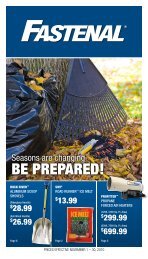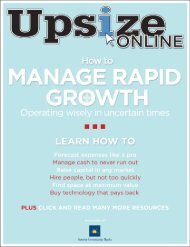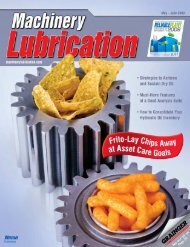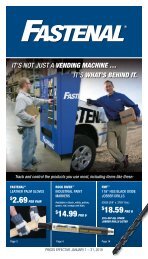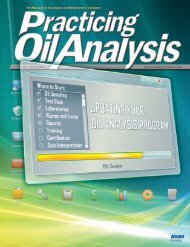Machinery Lubrication July August 2008
Machinery Lubrication July August 2008
Machinery Lubrication July August 2008
You also want an ePaper? Increase the reach of your titles
YUMPU automatically turns print PDFs into web optimized ePapers that Google loves.
LUBRICATION 101<br />
Abrasive Wear<br />
Other Names: plowing, cutting, gouging and broaching<br />
Two-Body<br />
Abrasion<br />
Three-Body<br />
Abrasion<br />
Hard Abrasive<br />
Abrasive wear occurs in sliding<br />
contacts, usually due to particle<br />
contamination.<br />
Machines/components affected by<br />
abrasive wear: piston/cylinders, swash<br />
plates, journal bearings, gears, cams,<br />
rolling element bearings<br />
Adhesive Wear<br />
“Soft” Surface<br />
“Hard” Surface<br />
“Hard” Surface<br />
“Soft” Surface<br />
Scuffing occurs on both sides of the pitch<br />
line. Changes tooth profile. Drives load<br />
density towards pitchline. Loss of involute<br />
profile increases gear noise.<br />
Adhesive wear occurs in highly-loaded, poorly<br />
lubricated slidingmachine contacts.<br />
Machine/components affectedby adhesive wear:<br />
• Pistons/cylinders • Swash plates<br />
• Gear contacts • Hypoid gears<br />
• Cams and followers • Rolling element bearings<br />
Corrosive Wear<br />
Fluid<br />
Uniform Attack<br />
Fluid<br />
Pitting Attack<br />
Imbedded<br />
Particle<br />
Scratch<br />
Marks<br />
Surface damage: scratch marking, scoring, furrows,<br />
grooves and polishing<br />
Influencing factors:<br />
• Surface hardness<br />
• Particle size/hardness<br />
• Alignment<br />
Juncture(cold weld)<br />
Fragment<br />
(material transfer)<br />
Fluid<br />
Intergranular Attack<br />
Fluid<br />
Subsurface Attack<br />
Corrosion wear is surface damage resulting from<br />
exposure to a reactive environment (atmosphere,<br />
moisture accumulation, bacteria, acids, electrolytes,<br />
process chemicals or lubricant by-products).<br />
• Film thickness (load,<br />
viscosity, speed)<br />
• Particle concentration<br />
Pitch Line<br />
Pitch Arc<br />
Scuffing and Adhesive Wear<br />
Machine surface damaged<br />
by adhesive wear<br />
Influencing Factors:<br />
• Similarity of mating surfaces<br />
• Antiscuff, EP, AW additives<br />
• Film thickness (load, viscosity,<br />
speed)<br />
• Gear tooth size<br />
• Surface roughness<br />
Corrosion rate (rust)<br />
typically doubles for every<br />
10°C (18°F) increase in<br />
temperature.<br />
Techniques to Reduce Corrosion:<br />
• Corrosion-resistant Metallurgy<br />
• Fluid Contamination Control (heat,<br />
moisture, water, acids, bacteria)<br />
• Protective Barrier (coatings, surface<br />
treatments, etc.)<br />
• Corrosion-controlling Additives (rust<br />
inhibitors, metal deactivators, overbase<br />
additive, etc.)<br />
of a bearing is the average time (in hours or cycles) to fail 10<br />
percent of a set of identical bearings under certain conditions.<br />
An estimate of the L10 life can be calculated, providing<br />
a rating life of a bearing.<br />
Surface-initiated Fatigue<br />
This begins with reduced lubrication regime and a loss of the<br />
normal lubricant film. The oil film is reduced to boundary or a<br />
mixed regime. Some metal-to-metal contact and sliding motion<br />
occurs. Surface damage occurs. The high points of the metal<br />
surface asperities are removed, which initially appear as a<br />
matted or frosted surface. This is not smearing, as in adhesion<br />
(discussed below). This type of surface damage is usually visible<br />
with a magnification of three to five times.<br />
The surface damage is coupled with the cyclic loading of the<br />
rollers rolling over the race. This creates asperity microcracks<br />
and microspalling. The cracks start at the surface and migrate<br />
down into the metal. An edge of metal is created at the surface<br />
which flexes at the edge of the surface crack. This creates a cold<br />
worked edge which is lighter in color. The cracks propagate and<br />
may intersect within the metal, and a piece of surface material<br />
is then removed. Flaking, mechanical pitting and micropitting<br />
are other names used to describe spalling.<br />
Surface fatigue can also occur as a result of plastic deformation<br />
(described below). Contaminant particles in the oil<br />
enter the high-load rolling contact area between rollers and<br />
the race, or between gear teeth, and cause some form of<br />
surface damage - a dent. Improper handling of bearings can<br />
cause similar surface damage.<br />
These round-bottomed dents often have a raised berm<br />
around their edges. The raised berm of metal acts as a point of<br />
increased load or stress, or creates a reduced lubrication regime<br />
(mixed or boundary), and leads to a lower surface fatigue life.<br />
Improved filtration reduces plastic deformation, and therefore<br />
indirectly reduces the occurrence of surface fatigue.<br />
Notice that the term “contact fatigue” is not used by ISO.<br />
This is a vague term sometimes used to describe both forms<br />
of fatigue. It does not specify whether metal flexing damage<br />
started in the subsurface or from some initial surface<br />
damage. It encompasses any change in the metal structure<br />
caused by repeated stresses concentrated at a microscopic<br />
scale in the contact zone between the rolling elements and<br />
raceways, and between gear teeth.<br />
Abrasive Wear<br />
Abrasive wear is estimated to be the most common form<br />
of wear in lubricated machinery. Particle contamination and<br />
36 <strong>July</strong> - <strong>August</strong> <strong>2008</strong> machinerylubrication.com <strong>Machinery</strong> <strong>Lubrication</strong>


